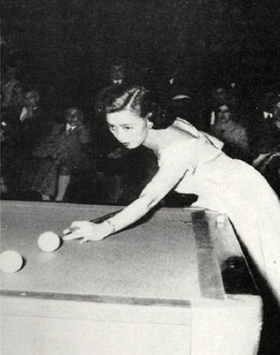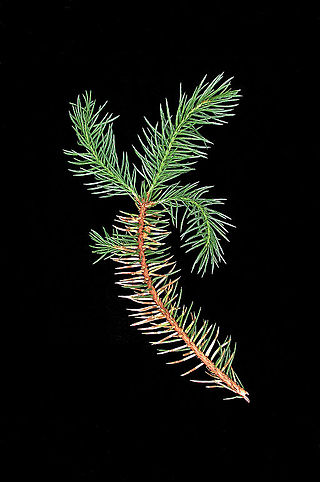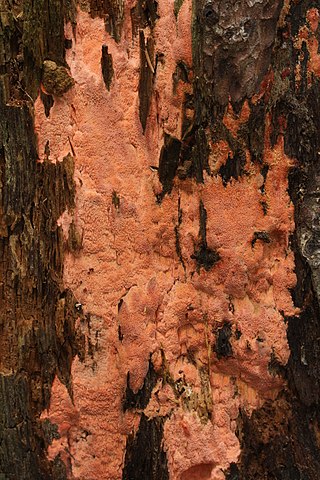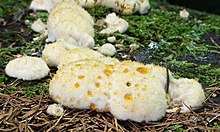
The Polyporales are an order of about 1,800 species of fungi in the division Basidiomycota. The order includes some polypores as well as many corticioid fungi and a few agarics. Many species within the order are saprotrophic, most of them wood-rotters. Some genera, such as Ganoderma and Fomes, contain species that attack living tissues and then continue to degrade the wood of their dead hosts. Those of economic importance include several important pathogens of trees and a few species that cause damage by rotting structural timber. Some of the Polyporales are commercially cultivated and marketed for use as food items or in traditional Chinese medicine.

Polypores are a group of fungi that form large fruiting bodies with pores or tubes on the underside. They are a morphological group of basidiomycetes-like gilled mushrooms and hydnoid fungi, and not all polypores are closely related to each other. Polypores are also called bracket fungi or shelf fungi, and they characteristically produce woody, shelf- or bracket-shaped or occasionally circular fruiting bodies that are called conks. Over one thousand polypore species have been described to science, but a large part of the diversity is still unknown even in relatively well-studied temperate areas.

Phallaceae is a family of fungi, commonly known as stinkhorns, within the order Phallales. Stinkhorns have a worldwide distribution, but are especially prevalent in tropical regions. They are known for their foul-smelling, sticky spore masses, or gleba, borne on the end of a stalk called the receptaculum. The characteristic fruiting-body structure, a single, unbranched receptaculum with an externally attached gleba on the upper part, distinguishes the Phallaceae from other families in the Phallales. The spore mass typically smells of carrion or dung, and attracts flies, beetles and other insects to help disperse the spores. Although there is great diversity in body structure shape among the various genera, all species in the Phallaceae begin their development as oval or round structures known as "eggs". The appearance of Phallaceae is often sudden, as gleba can erupt from the underground egg and burst open within an hour. According to a 2008 estimate, the family contains 21 genera and 77 species.

Pneumocystis jirovecii is a yeast-like fungus of the genus Pneumocystis. The causative organism of Pneumocystis pneumonia, it is an important human pathogen, particularly among immunocompromised hosts. Prior to its discovery as a human-specific pathogen, P. jirovecii was known as P. carinii.

A wood-decay or xylophagous fungus is any species of fungus that digests moist wood, causing it to rot. Some species of wood-decay fungi attack dead wood, such as brown rot, and some, such as Armillaria, are parasitic and colonize living trees. Excessive moisture above the fibre saturation point in wood is required for fungal colonization and proliferation. In nature, this process causes the breakdown of complex molecules and leads to the return of nutrients to the soil. Wood-decay fungi consume wood in various ways; for example, some attack the carbohydrates in wood, and some others decay lignin. The rate of decay of wooden materials in various climates can be estimated by empirical models.

Postia tephroleuca, also known as greyling bracket, is a species of fungus in the family Fomitopsidaceae infecting broad-leaved trees, typically beech and plane.

Postia is a genus of brown rot fungi in the family Fomitopsidaceae.

Rhizina undulata, commonly known as the doughnut fungus or the pine firefungus, is a species of fungus in the family Rhizinaceae. The fruit bodies of the fungus are dark purple brown with a bright yellow margin, crust-like and attached to the growing surface by numerous root-like yellow rhizoids. R. undulata has a cosmopolitan distribution, and commonly occurs on clearings or burned areas throughout central and northern Europe, North America, northern Asia, and southern Africa. It is parasitic on conifer seedlings, and has caused considerable damage to tree plantations worldwide.

Masako Katsura, nicknamed "Katsy" and sometimes called the "First Lady of Billiards", was a Japanese carom billiards player who was most active in the 1950s. She was the first woman to compete and place among the best in the male-dominated world of professional billiards. First learning the game from her brother-in-law and then under the tutelage of Japanese champion Kinrey Matsuyama, Katsura became Japan's only female professional player. In competition in Japan, she took second place in the country's national three-cushion billiards championship three times. In exhibition she was noted for running 10,000 points at the game of straight rail.

Hydnellum ferrugineum, commonly known as the mealy tooth or the reddish-brown corky spine fungus, is a species of tooth fungus in the family Bankeraceae. A widely distributed species, it is found in north Africa, Asia, Europe, and North America. The fungus fruits on the ground singly or in clusters in conifer forest, usually in poor or sandy soil. Fruit bodies are somewhat top-shaped, measuring 3–10 cm (1–4 in) in diameter. Their velvety surfaces, initially white to pink, sometimes exude drops of red liquid. The lower surface of the fruit body features white to reddish-brown spines up to 6 mm long. Mature fruit bodies become dark reddish brown in color, and are then difficult to distinguish from other similar Hydnellum species. H. ferrugineum forms a mat of mycelia in the humus and upper soil where it grows. The presence of the fungus changes the characteristics of the soil, making it more podzolized.
Pulvinula cinnabarina is a species of apothecial fungus belonging to the family Pyronemataceae. This is a European fungus of sandy soils, sometimes occurring at fire sites. The small orange, cushion-shaped ascocarps appear in summer and early autumn.

Chrysomyxa weirii, is a fungus that causes a disease, commonly known as Weir's cushion rust, of spruce trees. It is mostly a cosmetic problem, causing yellowish spotting and banding on spruce needles, but in some cases can cause severe premature defoliation. Weir's cushion rust can also disfigure and reduce growth of spruce trees by targeting the tender needles of newly emerging shoots. This pathogen's spores are spread by wind and water splash and germinate to infect newly developing needles on the same spruce, or neighboring spruce trees. Unlike many other rust disease pathogens, C. weirii is autoecious, only infecting spruce trees. C. weirii is also microcyclic, producing only two of the five possible spore stages common in rust fungi. Trees affected by Weir's cushion rust usually have obvious symptoms, but if treated correctly, the disease can be managed.

Hallomenus axillaris is a species of fungus beetle in the family Tetratomidae. It was described by German entomologist Johann Karl Wilhelm Illiger in 1807. It is found in Europe. In the Moscow region, it has been recorded growing in the fruitbodies of the fungi Hapalopilus rutilans, Laetiporus sulphureus, Polyporus squamosus, Postia fragilis, Pycnoporellus fulgens, Tyromyces chioneus, and Fomes fomentarius.

Rhodonia placenta is a species of crust fungus in the family Fomitopsidaceae. A brown rot species, it is found in China, Europe, and North America, where it grows on decaying conifer wood.
Ceriporiopsis pseudoplacenta is a species of poroid crust fungus in the family Phanerochaetaceae. It was described as a new species by mycologists Josef Vlasák and Leif Ryvarden in 2012. The type specimen was collected in Bogachiel State Park, Washington, where it was found growing on a coniferous log. It is named for its superficial similarity to Postia placenta.
Postia cylindrica is a species of poroid fungus in the family Fomitopsidaceae. Found in Southern China, it was described as a new species in 2017 by Hai-Sheng Yuan. The type collection was found growing on a dead pine tree in Jiangxi. The fungus is characterized macroscopically by crust-like to effused-reflexed fruit bodies with a cream to buff coloured cap surface and a reddish-brown margin that curves inward. There are gloeoplerous (oily) hyphal cells in the cuticular layer, and an absence of cystidia in the hymenium. The fungus produces smooth, cylindrical, thin-walled spores measuring 4.7–5.2 by 1.3–1.5 μm.
Postia duplicata is a species of poroid fungus in the family Fomitopsidaceae that was described as a new species in 2014. It is found in Yunnan and Zhejiang provinces of China, where it causes a brown rot on angiosperm wood. The fungus is named (duplicata) for its characteristic two-layered context, a feature that distinguishes it from other Postia species. The spores made by this fungus are cylindrical, hyaline, smooth, and typically measure 3.8–5.8 by 1.8–2.5 μm.
Postia amylocystis is a species of poroid fungus in the family Fomitopsidaceae. Found In China, the fungus was described as new to science in 1994 by mycologists Yu-Cheng Dai and Pertti Renvall. The original type collections were made in the Changbai Mountain Range, where the fungus was found growing on a decayed trunk of Manchurian lime. Characteristics that distinguish P. amylocystis from other Postia species include thick-walled cystidia in the hymenium, and narrow, sausage-shaped (allantoid) spores. The specific epithet amylocystis refers to the amyloid cystidia, and hints at a possible phylogenetic relationship to Amylocystis lapponica.

Postia lateritia is a species of fungus belonging to the family Fomitopsidaceae.
Postia leucomallella is a species of fungus belonging to the family Fomitopsidaceae.














